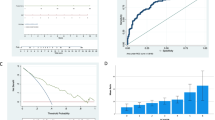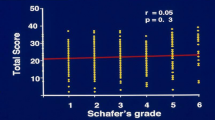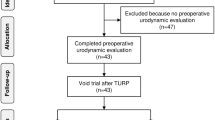Abstract
A total of 48 patients with BPH were studied before and after TURP. Initial diagnostic evaluation consisted of clinical examination, IPSS, uroflowmetry, cystometry, and “pressure-flow” study. Contribution of the important urodynamic measurements for the favourable symptomatic outcome was evaluated. There was significantly better result in patients with severe symptoms preoperatively (p=0.03), low preoperative Qmax (p=0.03), and presence of obstruction (p=0.004), especially in patients with normal or strong detrusor contraction. Preoperative volume of residual urine as well as detrusor instability were not important for the symptomatic outcome.
IPSS and uroflowmetry should not be treated as optional diagnostic tests. They improved the percentage of patients with an excellent symptomatic outcome from 62.5% to 90% (p=0.04). “Pressure-flow” study is the reliable method for the achievement of excellent symptomatic outcome, but not significantly better than uroflowmetry and IPSS together. “Pressure-flow” study should be performed only in inconclusive preoperative cases.
Similar content being viewed by others
References
Yalla, V. S., Sullivan, M. P., Lacemvasm, S. H., DuBeau, E. C., Vickers, A. M., Cravalho, G. E.: Correlation of American Urological Association symptom score with obstructive and nonobstructive prostatism.J. Urol., 153, 674 (1995).
Aso, Y.: Clinical research criteria. In: Cockett, A. T. K., Khouri, S., Aso, Y., Chatelain, C., Dennis, L., Griffits, K., Murphy, G. (eds.): Proceedings III International Consulation on Benign Prostatic Hyperplasia (BPH), Monaco, June 1995, Jersey: Scientific Communication International, 1995, p. 451.
Medersbacher, S., Klinger, C., Shatzl, G., Stuling, T., Schmidbauer, C., Marberger, M.: Age related urodynamic changes in patients with benign prostatic hyperplasia.J. Urol., 156, 1662 (1996).
Meyhoff, H. H., Nordeling, J.: Long term results of transurethral and transvesical prostatectomy.Scand. J. Urol. Nephrol., 20, 27 (1986).
Roehrborn, G. C.: American Urological Association symptom index—concerns and confirmation.J. Urol., 155, 1975 (1996).
Hald, T.: The urinary bladder in obstruction and ageing. In: Cockett, A. T. K., Khouri, S., Aso, Y., Chatelain, C., Dennis, L., Griffits, K., Murphy, G. (eds): Proceedings III International Consultation on Benign Prostatic Hyperplasia (BPH), Monaco, June 1995, Jersey: Scientific Communication International, 1995, p. 123.
Abrams, P.: The diagnosis of bladder outflow obstruction. In: Cockett, A. T. K., Khouri, S., Aso, Y., Chatelain, C., Dennis, L., Griffits, K., Murphy, G. (eds): Proceedings III International Consultation on Benign Prostatic Hyperplasia (BPH), Monaco, June 1995, Jersey: Scientific Communication International, 1995, p. 297.
Javle, P., Jenkins, S., West, C., Parsons, K.: Quantification of voiding dysfunction in patients awaiting for transurethral prostatectomy.J. Urol., 156, 1014 (1996).
Leriche, A.: Mechanisms of functional symptoms of benign prostatic hypertrophy. Pathophysiology and symptoms. In: Prostate et alpha bloquants. Excerpta Medica, 1989, p. 285.
Cucchi, A.: A possible condition of pre-instability in prostatic obstruction.J. Urol., 153, 681 (1995).
Cucchi, A.: The development of detrusor instability in prostatic obstruction in relation to sequentional changes in voiding dynamics.J. Urol., 151, 1342 (1994).
Author information
Authors and Affiliations
Rights and permissions
About this article
Cite this article
Ignjatovic, I. Prediction of unfavourable symptomatic outcome of transurethral prostatectomy in patients with the relative indication for operation. International Urology and Nephrology 29, 653–660 (1997). https://doi.org/10.1007/BF02552182
Accepted:
Issue Date:
DOI: https://doi.org/10.1007/BF02552182




